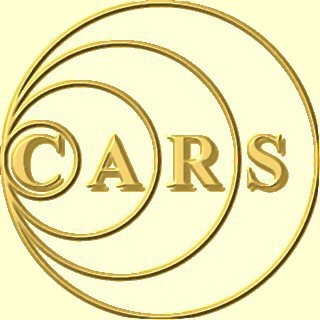 |
G0MWT, GX0MWT
International Marconi Day - 2006 |
 |
G0MWT, GX0MWT
International Marconi Day - 2006 |
International Marconi Day - 22nd April, 2006.
IMD is the first Sandford Mill open day of the year and its main purpose is to celebrate Marconi's birthday with radio amateurs setting up radio transmitting and receiving equipment at locations with a Marconi connection. The organisers are located at Poldhu, Cornwall the site of the first wireless transmitting station to span the Atlantic. The Chelmsford Amateur Radio Society has the great privilege of setting up their station in the famous Writtle Hut, used for the first wireless broadcasts in the early 1920's.
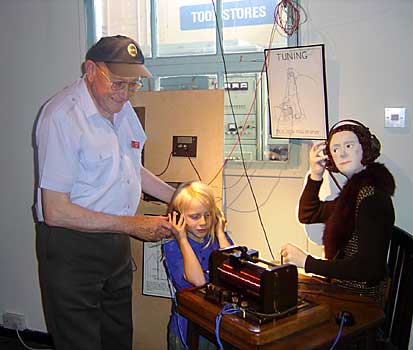
Tony, G4YTG demonstrating a crystal set with a Visitor, in 2005
All photographs by Colin, G0TRMEach year Dr Geoff Bowles (Keeper of the Museum) tries to have something new to attract visitors and this year was no exception. Last year he started to redecorate the interior of the Writtle Hut and with the aid of the Monday Morning gang the interior of one of the rooms was cleaned up and the walls painted in the original colours using authentic materials. It has now been completely transformed. Peter Watkins has painted two topical backdrops which can be viewed through the rear windows. With velvet drapes the room looks just like a 1920's sitting room.
As usual our two friends from the one-time Marconi Marine Company, Joe Ryan and Jimmie Leadbitter were manning the ship's radio room and meeting former radio officers and their families, and explaining maritime communication to visitors.
There were two new 'hands on' demonstrations this year. One was a demonstration of automatic Morse transmission and reception, with the help of Colin Page from CARS, which created quite a lot of interest, particularly with the younger visitors.
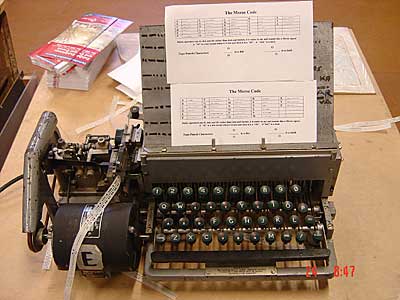
The Museum's Automatic Tape Punch - keyboard produces the Morse characters on the paper tape.The paper tape produced by the punch (above) is read by the Tape Reader, the output of which is fed to a radio transmitter.

The Museum's Automatic Tape Reader - reads the punched tape to feed the Transmitter.The Morse signals, having been received from the distant end, are converted to DC and fed to the Morse Printer which prints the Morse characters on a paper tape that can then be read.
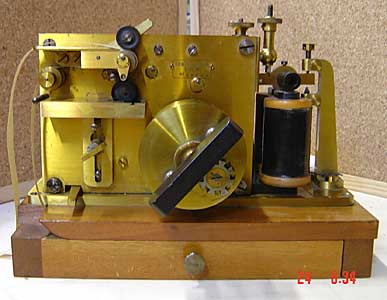

Two views of the Museum's Paper Tape Printer. These were made in Germany by Siemens & Halske in about 1850. The arm on the front winds the clockwork mechanism. The solenoid (right) activates the ink marker system & tape transport.
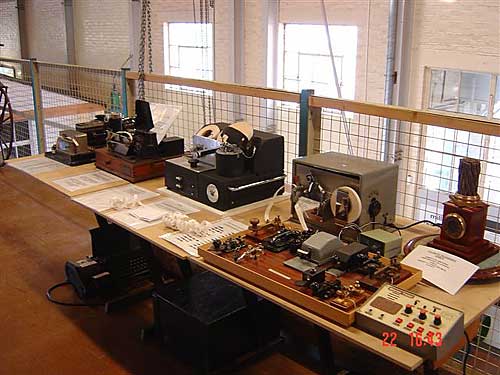
Desk laid out with various Morse Telegraph equipments, Readers, Undulators and Morse Keys by Colin, G0TRM.

A further display of Telegraph equipments (from left to right) Early German Morse Key, Hand operated tape punch, Early Galvanometer and a Telegraph Line Relay.
The other was a re-vamped and expanded demonstration of the modulation process used in medium and short wave broadcasting. Unfortunately this suffered interference generated by the amateur transmissions but this problem has now been overcome by the insertion of filters.
Members of CARS operated two stations, coming on the air at midnight and carrying through 'till closing time. Although propagation conditions were not ideal, both stations managed in excess of 250 contacts each. An example of the way the ionosphere can vary by the minute was demonstrated dramatically. Geoff, G3EDM made SSB contact with Australia and New Zealand but due to the erratic propagation conditions this only lasted for about 15 minutes and then went dead for the rest of the day. This sort of thing adds fascination to amateur radio but it can also be a source of frustration! Steve, G4ZUL also made contact with Cape Cod (Newfoundland), where the first signals were received.
Although it is unusual to find the cutting edge of technology displayed in a museum, the demonstration of a live display from the latest weather satellite EUMESTAT 8 by Harry Heap, G5HF, President of CARS, proved very popular with both young and old, keeping him busy all day. The data is sent back to earth via the HOTBIRD satellite and is viewable on low cost equipment. Over the course of the day, six hours worth of weather movement could be seen on the laptop screen, together with land, sea and cloud-top temperatures and other weather data. A storm over northern Australia was depicted where the cloud top was at minus 63 degrees Celsius with a severe thunderstorm.
In marked contrast the weather at Sandford Mill was absolutely ideal and with 580 visitors it was probably the most successful IMD on record, possibly helped by increased publicity throughout the town and in the amateur radio press.
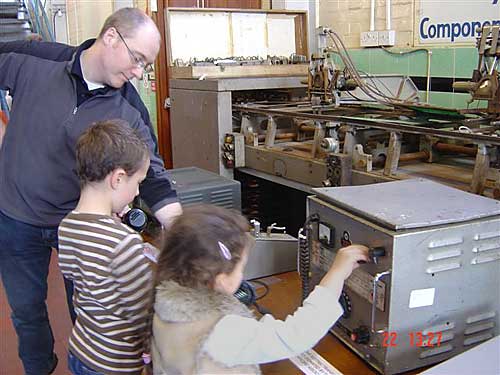
Young Radio Officers in the making?
In the background is one of the first automatic component insertion machines for printed circiut boards.
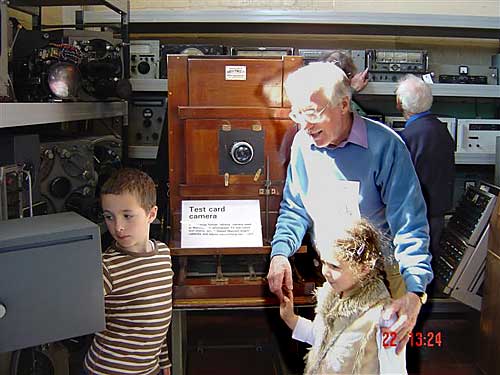
Colin, G0TRM & Grandchildren looking at a Marconi TV Camera.
As usual the "Friends of the Museum" provided refreshments throughout the day under the expert supervision of Kathleen Selby, assisted by Pauline Keiff and Janet and Alastair Goss. Their combined efforts produced a stunning profit for FCM funds. The Friends were out in force throughout the day and our thanks to Michael Clark, Gordon Iles, John Jay, Jim Selby, Ian Walker and Peter Watkins all dressed and looking very smart in light blue Sandford Mill sweat shirts. Together with our other friends from the Monday Morning Gang it all went to make a very enjoyable and successful day.
Sandford Mill will be open every Sunday afternoon in 2006, from 2 to 5 pm, in August and all day on Sunday, 24th September for Science Discovery Day.
Many thanks for the report by Geoff Lovegrove, G7KLV & a FCM Committee Member.
Other Marconi Stations were on the air - see more details by clicking below.
To RETURN to the Previous Events & Sandford Mill Page - Click Here
To RETURN to CARS Home Page - Click
Here